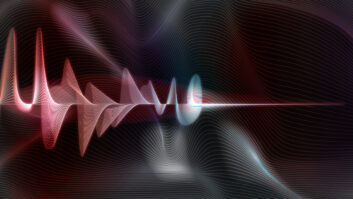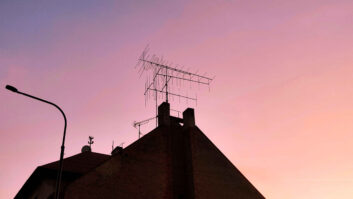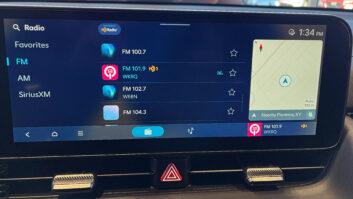
The Zoom H4n used by RTÉ Radio. OTTAWA, Ontario — Solid-state recorders have become the field units of choice for the BBC, Voice of America, Raidió Teilifís Éireann and Canadian broadcasters Corus Radio and Rogers Radio. In making the move from MiniDisc and analog cassette tape, these broadcasters are enjoying longer recording times and enhanced audio quality.
“VOA reporters primarily use the Marantz PMD620 recorder, which records to an SD card,” said Gary Jaffe, a radio broadcast technician at VOA’s Broadcast Operations Division. “With 16 or 32 GB memory cards, the record times exceed eight hours. The audio quality is excellent.” “The limiting factor is the quality of the microphone and mic preamp,” he said. “VOA reporters primarily use Electro-Voice 635a mics. In noisy locations, Sennheiser HMD 25-1 sportscaster headsets are used.”
Broadcasters still favor handheld mics because they allow reporters to display “station flags” that show up in TV reports and newspaper photos. What they’re using Like VOA, BBC World Service is using the Marantz PMD620. This is a handheld digital audio recorder with multi-in microphones. It records either stereo WAV or MP3 files.
“We’ve gone the usual route, from the Sony Walkman Pro to Marantz PMD600 series via a short-lived time with MiniDisc,” said Jeff Brown, senior studio manager for BBC World Service. Despite its small size, the PMD620 “delivers a lot of functionality.”
BBC is using external microphones too, namely the beyerdynamic MCE 58 microphone supplemented with beyerdynamic DT 231 headphones. “We are in the process of evaluating the Olympus LS–20M, which as well as recording audio is capable, at the flick of a switch, of recording HD video,” Brown said. “All of our language services have their own websites, so the ability of being able to capture short video clips is an advantage.”
Rogers Radio’s 680News Toronto also uses Marantz solid-state recorders, in this case the PMD661. “This is a small, rugged handheld,” said Scott Metcalfe, news director at 680News. “Besides its use of flash media, we like the fact that the PMD661 comes with professional XLR connections. These are much tougher than the consumer-grade mini jacks found on some units.” Also similar to VOA, 680News sends its reporters out with wired handheld Electro-Voice 635a mics. “The 635a is tough,” said Metcalfe. “You can drive a nail with it, and it will keep on working.”

VOA’s South Korea-based Asia correspondent Steve Herman, reporting from Japan following the 2011 tsunami. He was using an older model Sony digital audio recorder. Credit VOA. At Ireland’s RTÉ Radio, “Marantz PMD620 and the Zoom H4n are currently the two models we promote,” said Michael O’Rourke, RTÉ Radio’s head of technology. “They both have inbuilt mics, but many of the reporters use external mics. The Zoom H4n is a better machine in this regard, in that they have phantom power and a proper XLR connector. The Marantz PMD620 uses a mini jack connector, which can be noisy because it’s a mechanically weak connector.”
Finally, Corus Radio’s Talk Radio AM640 in Toronto is using the HHB FlashMic DRM85. Because the FlashMic is literally a microphone with a built-in digital audio recorder, mounting mic flags is not a problem.
“We made the switch from Marantz in 2010 as part of our move into our new Corus Quay facilities,” said James MacPhee, AM640’s news director. “The HHB model is easier to use and links up better with our computer system than the Marantz did.” Advantages, disadvantages Recording digitally on solid-state media offers a number of advantages to broadcasters, two of which are extended recording time and superior audio quality. Easy integration with digital editing/playout systems is also a big advantage: “The HHB can be plugged directly into a laptop and the audio clips quickly transferred into our Burli sound-editing system,” said AM640’s MacPhee.
In addition, solid-state recording allows reporters to edit content in the field. At the BBC World Service, “once audio and video is recorded, our reporters use either a Mac or a Windows laptop to edit and send the media back to London,” said Jeff Brown. “Previously we would rely on FTP, which would be manually downloaded in London. But we now have web-based portals, which can ingest the material directly into the audio or video servers here.” RTÉ Radio uses a similar approach. “Reporters have Windows laptops that have the Radioman QEP audio editor,” said O’Rourke. Files are FTPed from the field directly to dedicated watch folders. This allows for very quick turnaround of clips from the field. For live reports, reporters can insert their own clips either by using a clip list on their laptop or by playing directly from the recording device.”
Despite their advanced production capabilities, solid-state recorders are remarkably tough, even in the harshest of environments. The secret is their architecture: Having “few mechanical parts, they are not susceptible to temperature and humidity changes and mechanical shock,” said VOA’s Gary Jaffe. As well, “Solid-state recorders are not affected as much by environmental factors as are mechanical and optical devices. For extreme cold, the limiting factor is usually the battery.” On the downside, solid-state recorders “use lots of batteries,” O’Rourke said. Meanwhile, the less expensive PMD620s used by the BBC World Service are not as rugged as the PMD661s.
“Having said that, we get very few faulty or broken items back,” said Brown. “And the ones that do break can easily be replaced — although sometimes the hardest part is getting equipment out to places such as Kabul or Mogadishu.”
Looking Ahead
Solid-state audio recorders have revolutionized radio field reporting. But broadcasters are already looking forward to newer alternatives. For instance, “We have been experimenting with (the iPhone-based app) Luci Live and have completed a pilot,” said O’Rourke. “We are now starting to roll it out with an initial investment in 30 licenses. We are moving toward the iPhone/iPad as standard equipment for both video/audio field journalists.” Over at the BBC World Service, “Some of our reporters use iPhones to deliver audio using Luci Live,” said Brown. “However, you have to consider where the reporter is and how unusual/valuable/attractive an iPhone would be to someone else; plus, of course, what Internet and 3G coverage is available.”
Until Luci Live and other alternatives prove their worth, solid-state recorders will likely remain radio news’ field equipment of choice for years to come. “The biggest advantage is that as [solid-state] technology has developed, recorders have reduced in size, memory has become cheaper, capacity has increased and prices of equipment that can deliver good quality audio have dropped,” said Brown. “The ability for our reporters in the field to record, mix and deliver a package has never been better.”
James Careless reports on the industry for Radio World from Ottawa, Canada.







